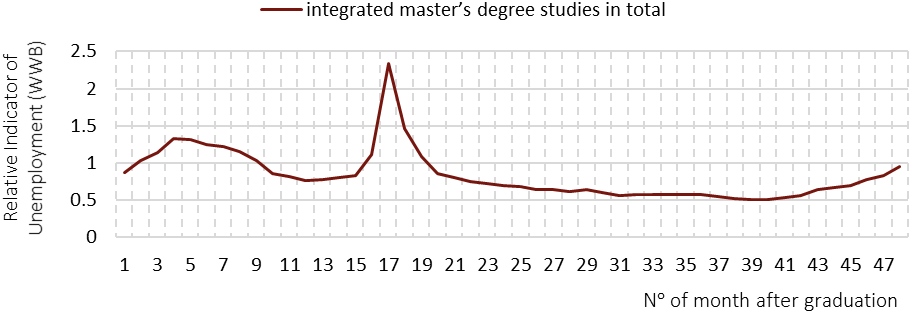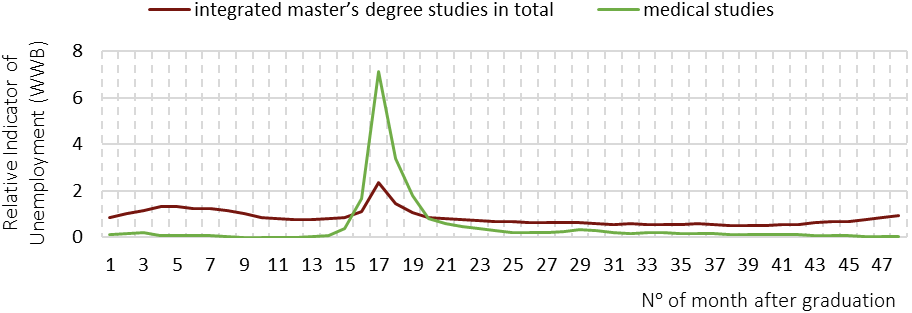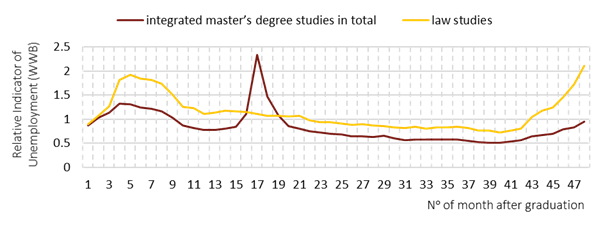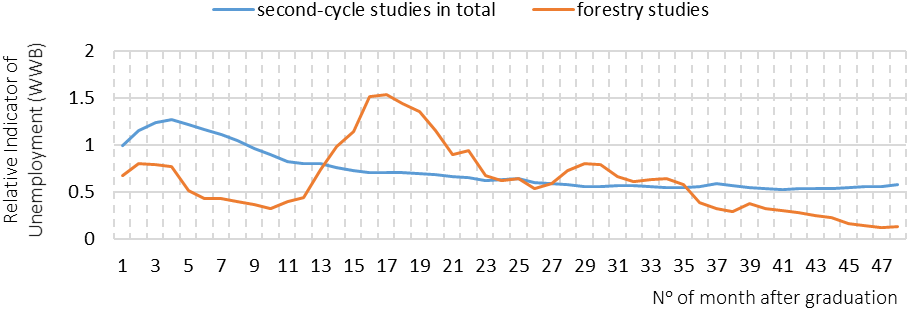
The ELA system (Polish Graduate Tracking System) results unveil interesting anomalies in the values of unemployment indicator for graduates of integrated master’s degree studies. The graduates of the integrated master’s degree studies go on unemployment in massive numbers around the seventeenth month after graduation. The situation – albeit on a smaller scale – repeats in the fourth year after graduation. What is the reason behind it?

Integrated master’s degree studies are offered only in a limited number of fields, namely: law, medicine, dentistry, veterinary medicine, psychology, pharmaceutics, theology and some fields of arts. Graduates of some of these studies must complete additional internships and pass specialist exams before they can start working.
Medical students are responsible for the first sudden spike in unemployment among the graduates of integrated master’s degree programmes. After completing an internship and passing an exam giving the right to practice the profession of a medical doctor (Final exam for medical doctors, Medical-Dentist final exam) the graduates of medical studies have a short gap during which they cannot work as physicians yet. During the gap they register as unemployed en masse. After a few months virtually everyone takes up employment. As medical doctors are a large group, their actions take a toll on the graduate employment levels.

Thanks to an extended period of observation, the fourth edition of the Polish Graduate Tracking System allowed for the disclosure of a new trend which begins in the fourth year after graduation. That is when there is a recurrence, gradual and not so drastic this time, of a rise of unemployment among the graduates. This time the responsibility is on lawyers who after the three-year legal practice, at the onset of their independent activity on the job market, register as unemployed. And again – as lawyers are a numerous group – it has an influence on the general trend among university graduates. The next edition of the Polish Graduate Tracking System will cover the period of up to five years after graduation. We suspect that we will observe a reversal of this trend and the decrease of unemployment resulting from the fact that newly-minted lawyers will find jobs.

A similar situation can be observed not only for integrated master’s degree studies but also, for example, among the graduates of second-cycle studies in forestry in the year 2014. In their case a sudden uptick in unemployment ratio happens in several months after getting a diploma. That stems from the regulations specifying the rules to become a forester. Future foresters take part in a yearly internship in the organizational units of National Forests followed by passing of vocational exams. After this period, they enter the job market and register as unemployed. As can be seen on the chart below, a little later the indicator of unemployment among foresters decreases below the average unemployment rate among graduates of the second-cycle studies.

ELA knows everything about the economic fate of graduates
The Polish Graduate Tracking System (ELA) is developed by the National Information Processing Institute, and
commissioned by Ministerstwo Edukacji i Nauki. It aims to present the most comprehensive information on the situation
of graduates on the job market. The main source of information in the system are administrative data from two sources
– the Social Insurance Institution system (data, inter alia, about the professional situation of graduates:
employment, unemployment, wages) and the POL-on system (the Integrated System of Information on Science and Higher
Education), i.e. the information system about the higher education supporting Ministerstwo Edukacji i Nauki (it
contains information, inter alia, on the education of university graduates). Currently, the ELA system generates five
types of reports about the economic fate of tertiary education graduates: Job search and unemployment, Wages, Work
before and after graduation, Work and further studies, Geographical differentiation of graduates’ fate.